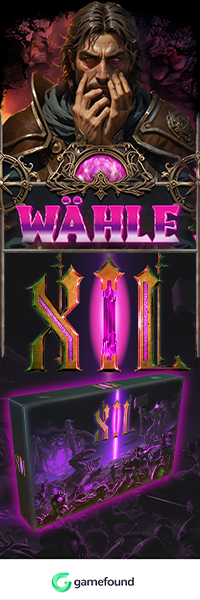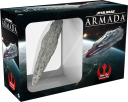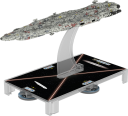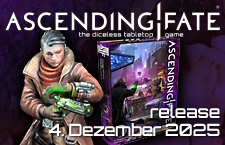Star Wars Armada: Home One Expansion
Fantasy Flight stellen die Home One vor.
„Proceed with the countdown. All groups assume attack coordinates.“
–Admiral AckbarIn our first preview of the second wave of expansions for Star Wars™: Armada, we looked at the Imperial-class Star Destroyer Expansion Pack and the many tactics its miniature Imperial-class Star Destroyer and upgrades make available to the Imperial Navy and its fans. Today, we press deeper into Wave II with a look at the Rebellion’s first large-base starship, the MC80 Mon Calamari star cruiser from the Home One Expansion Pack.
The miniature MC80 Mon Calamari star cruiser from the Home One Expansion Pack
The MC80 Mon Calamari Star Cruiser
The largest, best shielded, and hardest hitting of all Rebel ships to-date, the MC80 Mon Calamari star cruiser can be added to your fleet as either the MC80 Assault Cruiser or the MC80 Command Cruiser .
The MC80 star cruiser is the Rebellion’s best answer to the Imperial-class Star Destroyer, but they are in no way equivalent. There are numerous differences between them, and the wise admiral will be certain to study them, understand them, and adapt his tactics to account for them.
The first thing you’re likely to notice is that whereas the commander of an Imperial-class Star Destroyer wants to engage the enemy head-on to fire from the ship’s forward hull zone, the MC80 star cruiser attacks best from its left and right hull zones. This is an important distinction, especially when you consider that the Star Destroyer can equip a weapons team upgrade like the Gunnery Team while the MC80 star cruiser cannot.
For starters, it means that you won’t want to approach your enemy head-on. You want to move into position alongside your foe and fire from your broadside, or if you’re inclined toward a truly aggressive strategy, you can run your MC80 straight through the middle of your opponent’s fleet, firing six attack dice from each side of your ship. If you do this, your MC80 can actually fire as many dice per round as the Imperial-class Star Destroyer, which can fire eight from its front hull zone and four from its left or right hull zone for a total of twelve attack dice. However, if you perform this slashing maneuver, you’ll be forced to split your attack dice between two separate targets, and you’ll leave your star cruiser exposed to attacks from both sides.
Alternatively, the MC80 can easily be incorporated into a strategy in which you hope to circle your foes and fire at your opponent’s side or rear hull zones. If you have the initiative, you can fly two star cruisers in a line so that the first can fire and then fly forward, leaving room for the second to fire and fly forward after your opponent activates a ship. By concentrating your fire in this way, you’re likely to make short work of any enemy ship you prioritize.
Having won inititative, the Rebel player is able to activate an MC80 star cruiser before the Imperial player can activate the Victory-class Star Destroyer. The MC80 fires, then moves out of the Star Destroyer’s forward firing arc.
Next, the Imperial player activates the Star Destroyer. Forced to split its attacks between the two MC80s and to take its attack against the unactivated MC80 from long range, it fails to land any damage to either ship’s hull.
Finally, after the Imperial player is forced to maneuver the Star Destroyer into range of the second MC80s blue dice, the Rebel player launches an attack of six dice against the Star Destroyer, then flies to set up another broadside shot. If the Rebel player activates this second MC80 first in the next round, it can attack with all the dice from its right firing arc before flying away and denying the Imperial player a shot from the Star Destroyer’s devastating forward firing arc.
After you explore the differences between their attack dice, you’re likely to notice that the MC80 star cruiser costs you several fewer fleet points than the Imperial-class Star Destroyer costs the Empire. The MC80 Command Cruiser weighs in at 106 fleet points, compared to the Imperial I-class Star Destroyer’s 110, and at 114 fleet points the MC80 Assault Cruiser costs six less than the Imperial II-class Star Destroyer, which requires 120 of the Empire’s 400 available points. Despite this, however, you get the same overall number of hull points and shields, although more of those points are invested in shields than in hull points. This makes the MC80 cruiser slightly more tactical; you need to make good use of your commands and defense tokens to get maximum value from your shields. This fact only adds to the value of Walex Blissex , who allows you to recover one of the defense tokens you’ve previously spent.
Additionally, you’ll note that the MC80 star cruiser’s defensive tactics are built into even its upgrade bar. Both versions of the ship feature at least one defensive retrofit upgrade slot, while the MC80 Assault Cruiser actually features two. This means you can equip the Core Set’s Electronic Countermeasures to ensure that you always have at least one of your defense tokens available for use, and with all the shields you have spread across your hull zones, you can get tremendous value from the Advanced Projectors included in the Assault Frigate Mark II Expansion Pack. On top of these options, the Home One Expansion Pack adds another, the Cluster Bombs defensive retrofit, which you can discard to help your squadrons make short work of a TIE Bomber Squadron , or any other squadron that you can’t allow to keep blasting at your ship.
Finally, the MC80 star cruiser is slower than the Imperial-class Star Destroyer. The Star Destroyer has a maximum speed of three, but the MC80 has only a maximum speed of two. However, you can easily turn this disadvantage into a strength by equipping the Engine Techs support team. With a team of Engine Techs aboard your MC80, you can fly just as fast as the Imperial-class Star Destroyer anytime you reveal the navigation command, and you can do so with better maneuverability.
After revealing a Navigate command, the Rebel player maneuvers an MC80 around an asteroid field, but fails to set up a broadside attack against the Star Destroyer.
Accordingly, the Rebel player decides to exhaust the MC80’s Engine Techs to execute another speed „1“ maneuver. The MC80 guarantees itself a broadside shot against the Victory-class Star Destroyer, or if the Rebel player activates it first in the next round, it can concentrate fire against the Star Destroyer from both its forward and right firing arcs.
More than that, since you don’t actually have to lock your speed at „3,“ you won’t have to slow down to go back to speed „2,“ meaning that you’ll be able to stay within close range again on the next round.
Admiral Ackbar and the Home One
„We’ve got to give those fighters more time. Concentrate all fire on that Super Star Destroyer.“
–Admiral AckbarThe Rebel Alliance didn’t defeat the Empire with superior military strength. In fact, despite the great strength and resilience of their MC80 star cruisers, the Rebellion was greatly outmatched. Instead, it won the Galactic Civil War because its heroes worked together to accomplish tremendous feats and because they fought according to the designs of some of the galaxy’s shrewdest tactical minds, including that of Admiral Gial Ackbar, the Rebellion’s chief military commander and the individual responsible for commanding the Rebel fleet during the decisive Battle of Endor.
Admiral Ackbar arrives to Armada as a commander perfectly suited to the MC80 star cruiser and the Rebellion’s other broadside ships, such as the MC30c frigate, which we’ll explore in more detail in an upcoming preview. His ability reads:
„Before a friendly ship’s Attack Step, it may choose to attack from only its left and right hull zones this round. If it does, it may add 2 red dice to its attack pool while attacking a ship.“
At thirty-eight fleet points, Admiral Ackbar isn’t a cheap addition to your fleet, so you’ll want to make sure you’re going to take frequent advantage of his ability. However, if you can exploit his ability to its fullest, Admiral Ackbar can inspire your fleet to some truly devastating rounds of fire.
With both Admiral Ackbar and Enhanced Armament , an MC80 Assault Cruiser can fire as many as seven red attack dice. That’s easily enough to get the better of most exchanges fired at long range. You can even add yet another red attack die if you’re attacking from the Defiance against a ship that has already activated.
With all those red dice, though, and with all their potential damage, you’ll want to be certain to negate your opponent’s brace command as often as possible to avoid seeing your damage halved. That’s where the Home One title comes into play. The personal flagship of Admiral Ackbar, the Home One is one of the most important and iconic of all the Rebel starships presented in the original Star Wars trilogy, and it brings an appropriately powerful ability to your Armada battles:
„While another friendly ship at distance 1–5 is attacking, it may change 1 die to a face with an
icon.“
The thing to remember about red dice is that while they have the longest range, they are the game’s least accurate dice. Two of their faces are blank, and only one features an accuracy result. Thus, while Admiral Ackbar can increase your ability to concentrate your fire from long range, you’re likely going to need to modify your dice in order to get the most out of your results, and the Home One offers one of the best possible modifications to all friendly ships within range.
The ability to convert any one die face to an accuracy result can’t be overvalued. It can steer your shots to the hull zone you really want to hit, it can prevent your damage from being halved, or it can ensure that your critical hit against an Imperial-class Star Destroyer results in a faceup damage card. The fact that the Home One title can convert your other ship’s blank result to this accuracy result only makes it better, especially if you pair it with Leading Shots , so that you can reroll as many dice as you wish before choosing which to convert to an accuracy result.
Outnumbered and outgunned, the Rebel Alliance cannot hope to overpower the Empire. It must, instead, coordinate shrewd, tactical strikes, and there are few individuals better suited to lead such initiatives than Admiral Ackbar. Likewise, there are few better ships to support his command than the Home One, and you’ll be able to bring both Ackbar and the Home One to your battles when the Home One Expansion Pack arrives.
Make the Jump to Hyperspace
When Armada Wave II arrives, the game’s battles grow even larger, incorporating the first large-base ships for both the Empire and the Rebellion and increasing in scope to 400 fleet points. This means you’ll have even more space for exploring unique fleet designs. Will Admiral Ackbar, the Home One, and the Home One Expansion Pack play a part in your favorite Rebel fleet?
Der deutschen Vertrieb der Fantasy Flight Produkte liegt bei Heidelberger.
Link: Fantasy Flight Games


















it´s a trap!
Verdammt du warst schneller!
; P
schneller ich war diesmal, andermal du bestimmt auch schneller! (yoda voice) 😀
Verglichen mit dem Imperial class Sternenzerstörer für in etwa dieselben Punkte geradezu eine Lachplatte. Aber sie fügt sich gut in den Rest ein.
Ich frage mich nun nur umso mehr, wie dieses Monster (also der Imperial class Sternenzerstörer) vom Balancing her in das Spiel passen soll.
Lachplatte, wirklich? Du unterschätzt die Stärke des MC80 aber mal ganz gewaltig. Das Teil ist richtig übel weil es viele Möglichkeiten bietet. Ihn schwächer ein zu stufen als einen ISD ist grundlegend falsch.
Hmm… er ist weniger wendig als der ISD, Langsamer als der ISD, hat weniger Wumms als der ISD, weniger Hülle als der ISD…
Aber gut, dass mich ein Experte angeraunzt hat. Jetzt weiß ich ja, dass ich einfach nur zu doof bin.
Schalt mal nen Gang runter, ich habe dich nicht angeraunzt. Das würde anders aussehen. Ich habe mich nicht als Experte ausgegeben.
Ich habe darauf hingewiesen das du einige Punkte übersiehst und den Fehler machst nur von den Grundstats aus zu gehen.
Den MC80 bekommt man für einen großen Pott sehr leicht gewendet, durch Nav-Team. Ackbar den wir wohl des öfteren bei Rebellen sehen werden pusht die Breitseiten mal eben ohne weitere Ausrüstung auf 6 Rote Würfel bei sehr großen Flanken auf einem Schiff das sich mit Nav-Team leicht wenden läßt. Durch den billigen Defiance kommen wir auch relativ schnell auf 7 rote und 3 blaue Würfel. Dazu 2 Defensiv Slots womit man den MC80 auch gut zum Schaden tanken aufbauen kann. Alles in allem kein Schlechtes Schiff das sich durchaus nicht hinter dem ISD verstecken muß.
@Thorsten:
Auf dem Papier sieht der MC80 auch schwächer aus als der ISD. Aber das täuscht etwas, da man beim ISD eben vor allem auf die mächtige Frontbewaffnung schaut. Wie von den anderen schön erwähnt hat der MonCal dafür recht starke Breitseiten, die man bei den Rebellen noch ordentlich puschen kann. Wie erwähnt gibt es da die Karte mit der Breitseitenverbesserung, die jeder Seite einen roten Würfel zusätzlich spendiert. Und wenn man noch Ackbar mitnimmt, feuert so eine MC80 auf einmal mit 9 Würfeln pro Breitseite!
Das ist auch ein Punkt zwischen Rebellen und Imperium: Während das Imperium an sich schon recht stark wirkende Schiffe hat, die wenig Support benötigen, müssen die Rebellen weitaus mehr auf Charaktere und Equipment zurückgreifen, dafür kriegen die damit auch einen ordentlichen Kräfteschub.
@sybarith: Die Unterstellung grundlegender Falschheit ist auch ein Punkt bei dem man um das herunterschalten eines Ganges bitten könnte.
@Ferox21: Es mag ja sein, dass die Upgrades es wieder rausreißen, aber bei Preisen wie 38 Punkte für Ackbar sind wir wieder nah an dem Bereich wo man sich die Frage stellt: lieber ein Schiff upgraden bis der Arzt kommt oder eben doch einen zweiten Pott? Oder ein paar Jäger mehr?
Ich hoffe halt nur, dass es am Ende irgendwo doch wieder passt. Das Spiel macht so viel Spaß, da wäre es doof wenn man aus missverstandenem Fanservice (IC ISD groß, stark, mächtiges Bada-Bumm!) so früh solche Fehler macht.
Hmm…Hier unterstellen sich Leute doch permanent, dass der Vorredner „grundlegend falsch“ lag, oder das das „so leider nicht richtig“ sei“ u.v.m. – auch aus der BK-Redaktion.
@Thorsten:
Nun, einen Commander muss ja jede Seite mitnehmen, und die Rebellen haben da jetzt bisher eher mittelmäßige Auswahlen im Vergleich zu Tarkin oder Screed. Und Ackbar sehe ich da schon in der Nähe einer Tarkin, wobei gerade letzterer mit 2 oder gar 3 ISDs extrem eklig werden kann.
Am Ende braucht es aber sicher einige Spiele, bis man das Kräfteverhältnis richtig einschätzen kann. Ich halte es FFG aber noch zu Gute, dass die den ISD und den MC80 gegeneinander gebalanced haben. Die Frage ist nur, wie gut sich solche Monokulturen wie 3 ISDs plus Tarkin oder 3 MC80s plus Ackbar am Ende schlagen und ob was wirklich Spaß macht (ich denke eher nein).
@BK-Thorsten: Du hast doch in deinem Post praktisch behauptet ISD > all, da du den MC80 praktisch als Lachplatte im Vergleich hingestellt hast, was ich mit Meiner Aussage nur korrigiert habe. Von daher bleibe ich dabei das du aus dem Rahmen gefallen bist und du hast auch angefangen persönlich zu werden.
@Ferox21: Beim Imperium werden wir wohl ab udn an 2 oder gar 3 ISD´s sehen, bei den Rebellen bin ich mir nicht sicher. Einen MC80 als Flaggschiff mit Ackbar dürfte wohl oft dabei sein, aber ich halte die MC30 auch für höchst interessant, die scheinen auch gute Breitseiten zu haben und mit Ackbar zu harmonieren. Ich vermute fast das sie in einer Preislage mit den Gladiator des Imperums liegen also so im 60 Punktebereich. MC80 + 1-2 MC 3 und Nebulon B bzw. Corvetten dürfte sich wohl eher lohnen in Kombination. Oder Alternativ MC80 + 2 MKII Fregatten die mit Ackbar und Bordschützenteam bei den MKII ordentlich druck machen, ne MKII die insgesamt 12 rote Würfel aus der selben Seite Spuckt hat was.
Eine Nebulon B mit slaved turrets aus dem MC80 Pack könnte auch Spaß machen als Sniper, nur einmal Feuern dank der slaved turrets dafür, mit passenden Kommando, 5 rote Würfel für die Front die bis zu 10 Schaden verursachen können. Mit Ackbar in der Flotte hätte man so zur Not auch 4 rote und einen blauen Würfel für die Flanke, wenn man nicht weiter in ruhe snipen kann und sich weg bewegen muß.
Man sollte nicht vergessen, dass es dem ISD schwerer fallen dürfte, den Gegner vor die Front zu bekommen, als in Position für eine Breitseite zu kommen. Dazu dann noch die Fähigkeit von Admiral Ackbar, das kann schon schmutzig werden. Ob das Balancing passt, kann man aber natürlich erst nach ein paar Spielen sagen.
Naja, der IC ISD hat wirklich einen sehr großen Front-Arc und da liegt, wie du schon erwähnt hast die große Stärke. Man muss den ISD ausmanövrieren, um in die recht kleine Seite/Heck zu kommen. Das wird mit dem Pott hier etwas schwieriger, dafür braucht man die kleineren, schnelleren Schiffe der Rebellen.
Ackbar ist sehr gut, keine Frage (aber auch teuer wie Sau), aber ich habe hier bewusst erst mal nackt verglichen. Und ich meine ja nicht, dass die MC80 schlecht ist. Wie schon erwähnt, finde ich sie passt sich sehr gut ins Spiel ein. Ich bin mir nur eben unsicher was den IC ISD betrifft, denn 8 Würfel können durchaus ein unbeschädigtes Schiff mit ein wenig Glück komplett aus dem Spiel nehmen. Da sind die bösen schwarzen Würfel dabei. Und ich habe mich bei dessen Veröffentlichung deshalb zurück gehalten weil ich wissen wollte was die Gegenseite für 110 Punkte bekommt. Und ich bin da jetzt eher zu einem „Naja“ gekommen, auch wenn der Powerlevel der MC80 halt eher zu den bisher erschienenen Schiffen passt. Man kann mit dem Pott hier sicherlich bequem zwischen mehreren gegnerischen Schiffen hindurch fliegen und zu den Seiten kräftig austeilen, aber da muss man eben auch erst mal hin kommen.
Auf dem Papier wirkt der IC ISD jedenfalls furchtbar, auch verglichen mit der MC80. Bei einem Standoff der beiden würde ich im Moment mein Geld aufs Imperium setzen. Aber wie du schon schriebst: mal abwarten was das Schlachtfeld dazu sagt.
Gutes Preview. Wie schon oben erwähnt ist der MC80 doch ganz anders als der ISD und darf sich nicht länger als eine Runde in dessen Frontbereich aufhalten. Dafür können die Rebellen seine Breitseiten ungemein pushen und wenn man dann in die richtige Position kommt, kann so ein Schiff auch ordentlich Schaden austeilen.
Gefällt mir und ist in Gedanken schon gekauft.
Naja, ich werde mit Armada nach wie vor nicht warm:
So sind mir die großen Pötte noch deutlich zu kein ICSD und MC80 könnten aus meiner Sicht doppelt so groß sein und die „Tisch-Bases“ tun ihr übriges…
Vermutlich habe ich aber auch einen anderen Ansatz an ein Großkampfschiff Weltraumschlachtensystem was für mich nicht nur bedeutet dass die Größe der Großkampfschiffe im Verhältnis zu den Jägern zum tragen kommen muss um den Flaire zu vermitteln (das heißt nicht „Realistisch“ aber es sollte schon riesig wirken d.h. nicht im Verhältnis Infanterist -> Panzer sondern eher Panzer -> Kopf des Infanteristen); zum anderensollten die großpötte recht schwerfällig sein – nicht weil sie Langsam sind, sondern weil die Schlacht sich an ihnen Orientiert d.h. das Schlachtfeld wird nicht durch die Matte terminiert (die ist nur Kulisse) sondern durch die großen Pötte; wodurch auch es auch nicht so wichtig ist, dass die auf der Matte (die bei einem Armadaspiel selbst durchaus größer sein darf als bei einem Dogfightsystem) nicht so viel Bewegungsspielraum haben wenn sie fett sind, solange sie dabei das erwünschte Flaire vermitteln wo man sich aus Sicht des Besatzungsmitglieds oder Jägerpiloten denkt: „Gigantisch das Teil!“…
Klingt im Prinzip nicht schlecht.
Mit dem größeren Maßstab für die Großkampfschiffe bin ich auch ganz bei dir.
Aber wenn die Großkampfschiffe sich kaum bewegen so wie ich das jetzt verstanden habe, dann fehlt doch damit viel vom taktischen Tiefgang.
Oder?
Missverständlich – sie sollen sich schon bewegen, aber eben langsam und behäbig. Wo die Taktische Herausforderung nicht im schnellen Reagieren liegt (dafür sind die Jäger und kleinen Schiffe da), sondern darin ihre Position in mehreren Runden zu planen – ein bisschen wie das verschieben von größeren Infanterieregimentern in WHF o.ä.
Wenn man von den kleinen Platten wegkommt, wären im übrigen auch schiffe in Banebladegröße oder noch größer kein Problem -> mir schweben Tischtennisplatten als optimale Plattengröße vor; auf denen ist alles noch gut erreichbar und sie stehen zudem oft so, dass sie von allen Seiten gut zugänglich sind – das macht sie in meinen Augen optimal für größere Schlachten, nur hat sich halt ein anderer Maßstab durchgesetzt und große Platten sind meist erweiterte kleine, welche andere Seitenverhältnisse als Tischtennisplatten haben.
Die Großkampfschiffe sind recht träge, gerade wenn man sie mit den kleinen Schiffen oder den Jägern vergleicht. Und klein sind sie auch nicht, der ISD soll um die 20-21 cm lang sein, wie lang war der Baneblade? Um die 24 cm, oder?
Also wenn man die Star Wars Schiffe nun doppelt so groß machen sollte damit es passt, würden wir von 40+ cm sprechen. Das wäre schon unhandlich und sehr teuer.
Bisher ist auch nicht bekannt ob es bei den Ausmaßen beim ISD bleiben wird, oder ob man später noch eine Schippe drauf legt.
Naja, mir ist halt auf den Bildern zu Armada mit den verschiedenen Schiffsgrößen aufgefallen, dass das irgendwie alles nicht zusammen passt – die Jäger sind neben den SDs recht groß, Nebulon wirken neben den Blockaderunern zu filigran usw.
Ein Blockadrunner müsste ansich so lang sein wie 12 Jäger, das ist nciht machbar aber ist er kürzer als zumindest 7-8 wirkt er mAn zu klein.
Die Nebulon B ist so filigran dass man da das Größenverhältniss von 1:2 zum Runner an sich beibehalten muss.
Der VCSD muss jetzt nicht unbedingt 3x solang sein wie die Nebulon B aber es sollte schon spürbar mehr als Doppelt solang sein und der ICSD sollte zumindest etwa 1,5x solang sein wie der VCSD weil er sonst auch in Bezug auf den Runner deutlich zu klein wirkt (die Eingangsszene von „a New Hope“ hat jeder SW-Fan im Kopf und wenn man da den Armadarunner neben einen SD sieht, fühlt sich dass einfach nicht wie SW an, wenn da zu sehr gestaucht wurde – und schließlich muss der Millennium Falke auch hinten an die „Antenne“ passen).
Der Imperial Class Star Destroyer soll angeblich 25 cm lang sein.
Das wäre doch schon eine Hausnummer und würde auch im Verhältnis zum Victory Class Star Destroyer passen.
Ja, wie gesagt, dann sind einfach die kleinen schiffe (und Jäger) zu groß…
Wobei halt dass Problem ist, dass der Blockaderunner bei 25cm ansich weniger als 2,5cm lang sein dürfte (1600m zu 150m) und wenn man Maßstabstauchung zulässt, nahe 5cm und mehr am Ende immer noch zu viel werden…
Jeder SW-Fan wird wie gesagt die Eingangszene von „A new Hope“ im Kopf haben und ein zu großer Blockaderunner fällt da ziemlich direkt ins Auge.
Wenn man bei ICSD also bei 25cm bleibt ist die sinnvolle darstellung von Jägern ansich nicht mehr möglich, da man mit Schiffen wie Blockaderunner idealerweise auf etwa 3,5cm runter geht (Nebulon-B = 7cm, VCSD = 16cm) – ein Jäger dürfte also maximal 5mm lang sein um nicht deutlich überprortioniert zu wirken – ka. ob das Technisch möglich ist – auf Staffelbases vielleicht, dann aber keinesfalls auf so nem Tisch sondern auf ner Dünnen durchsichtigen Base auf hochwertigen dünnen schwarzen Stecknadeln)…